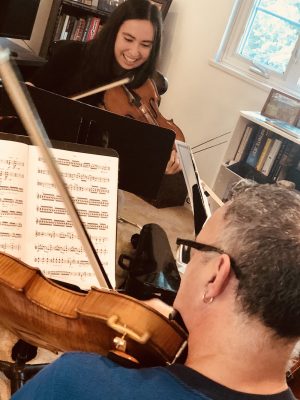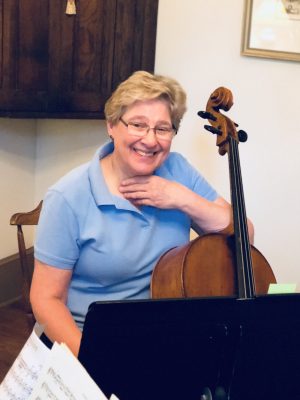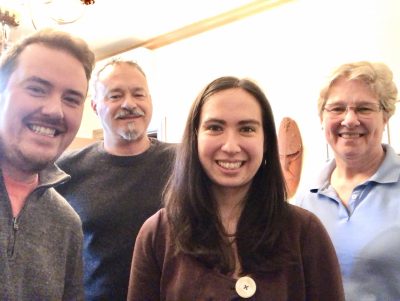The intimacy both classical music lovers and musicians find in chamber music promises to be evident in the National Philharmonic Chamber Players’ first concert of the 2017-18 season on Sunday, Oct. 29, at Potter Violins in Takoma Park. The ensemble is an offshoot of the National Philharmonic Orchestra in residence at the Music Center at Strathmore.
Potter’s intimate performance venue, the John Kendall Recital Hall, has only 90 seats. “The size allows concertgoers to experience chamber music as was originally intended, up close and personal,” said Colin Sorgi, the violist who is the chamber group’s director and the orchestra’s concertmaster (first violinist).

At first, the Chamber Players’ appearances were more happenstance. “Before last year, my colleagues and I had given some chamber performances together in other venues and decided we should expand the idea into a regular series,” said Sorgi.
The original motivation in launching a series was the perceived need and desire to connect with a wider audience and in a “more intimate way,” he added. “It is my personal belief–shared, I’m sure, by Piotr Gajewski, the National Philharmonic’s conductor and music director–that symphony orchestras can no longer rely on simply putting on really great concerts. We have to continually shape and redefine how we engage with our audiences.”
Assigning a thematic thread that ties everything together is one way to achieve such engagement. “This is by design, and is meant to give the listener something concrete to grasp onto as we travel through each program,” said Sorgi, who also appears regularly as a guest concertmaster, principal violist and in various recital and chamber music settings. “I think providing historical context and explaining the inspiration behind these pieces makes for a significantly more interesting and meaningful experience.”
Lori Barnet, the orchestra’s principal cellist and Chamber Players member, agreed. “The less-experienced listener, in particular, can really be helped through a challenging program by tracing the common elements,” she said. “It’s broadening horizons, getting everyone a little out of their comfort zones, and encouraging connections among pieces. I believe that old truism is the universal language, and organized programs are more understandable, even when the vocabulary–the individual compositions–are unfamiliar.”
Because small-scale chamber concerts are also “more mobile” than the NP orchestra performances, they allow the Chamber Players to bring “our brilliant musicians out into the surrounding community, all in the hope that these audiences will be so inspired, they’ll want to come hear the big orchestra play at Strathmore,” Sorgi added.

This year’s Chamber Players series explores the overarching theme of the relationship between music and the global community. The Oct. 29 concert, titled “Crossing Borders,” celebrates music with ‘dual citizenship,’ explained Sorgi, who oversees the Chamber Players’ programming. “We will feature Dvorak’s popular American ‘String Quartet,’ written while he was spending the summer in Iowa. It blends African American spirituals with a distinctly Czech flair.”
The program also includes: “Leyendas: An Andean Walkabout,” by Gabriela Lena Frank, an American composer born to a Peruvian/Chinese mother and Lithuanian/Jewish father; the “Italian Serenade,” by Hugo Wolf; and “Escalay” (Water Wheel) by Hamza El Din. “The works by Frank and Hamza El Din display dazzling transformations of traditional folk music that put the composers’ heritage front and center,” said Sorgi.
“I have been consistently part of whatever group has represented the orchestra in the chamber music sphere,” Barnet said. “Chamber music is my greatest musical passion, so any chance to perform in a small group is always a highly attractive prospect.”
The current lineup of the Chamber Players under the NP umbrella came into existence with Sorgi’s arrival as concertmaster in the 2014-2015 season. In addition to Sorgi and Barnet, the performers in the Oct. 29 string quartet concert are violinist Sara Matayoshi and violist Julius Wirth.
Even for classical-music lovers, chamber music may be an acquired taste. For Barnet, however, it is “the perfect marriage of the virtuosity of solo performance with the fun and interdependence of group performance. But unlike with so many group projects, there’s no one to cover for you, so there’s more risk and more satisfaction.”

She sees her role as a performer as to share her enthusiasm for the genre with audiences and “hopefully infect them as well.”
For musicians, and hopefully for their audience, listening to varied forms of music is rewarding. “Orchestral music is grand and exciting,” Sorgi said. “It’s quite an experience to see so many musicians grouped together on stage creating a staggering amount of sound. However–and this sounds so corny, but–chamber music is really where the composers give us a brief look into their hearts and souls. That is why you find so many string quartets, for example, which are more personal reflections for the composers.”
Sorgi attributes part of this dichotomy to the original functions of the two genres. Symphonies and operas were performed in grand halls and theaters, while string quartets and other forms of chamber music were meant for the private gatherings of family and friends. “It’s this communal, intimate setting that makes chamber music so profound,” he added. “And it’s truly the best and most natural way to connect with an audience on a deeper level.”
“Crossing Borders” will be performed from 3 to 5 p.m. on Sunday, Oct. 29, at Potter Violins, 7111 Eastern Ave., Takoma Park. Tickets are $18 online, $20 at the door and free for students, ages 18 and younger. Call 301-652-7070 or visit http://classicalmusicconcert.org/event/national-philharmonic-chamber-players-3. View this concert on CultureSpotMC here.